The Conversational AI Market is estimated to be valued at USD 13.2 billion in 2025 and is projected to reach USD 65.1 billion by 2035, registering a compound annual growth rate (CAGR) of 17.3% over the forecast period.
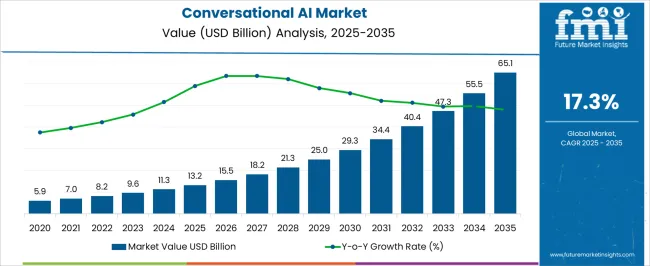
| Metric | Value |
|---|---|
| Conversational AI Market Estimated Value in (2025 E) | USD 13.2 billion |
| Conversational AI Market Forecast Value in (2035 F) | USD 65.1 billion |
| Forecast CAGR (2025 to 2035) | 17.3% |
The conversational AI market is expanding rapidly as enterprises prioritize automation, customer engagement, and cost efficiency in service delivery. Advances in natural language processing, machine learning, and speech recognition have significantly improved conversational accuracy and contextual understanding, making AI driven interactions more human like.
Rising digital adoption across industries, coupled with growing consumer expectations for 24x7 support, has accelerated integration of conversational platforms. Cloud based solutions are enabling scalability and cost effectiveness, while data privacy regulations are encouraging secure AI deployments.
The increasing focus on multilingual capabilities and personalization is further strengthening adoption across global markets. Looking ahead, the market is poised for robust growth as enterprises continue to integrate conversational AI into omnichannel strategies, customer service models, and enterprise workflows to improve efficiency and user satisfaction.
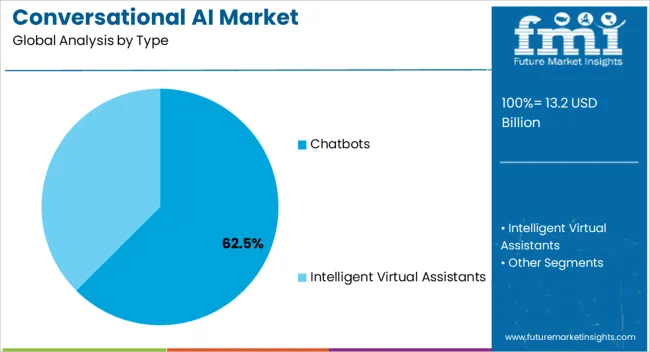
The chatbots segment is projected to account for 62.50% of total revenue by 2025 within the type category, making it the dominant segment. Growth in this segment is driven by the ability of chatbots to automate high volume customer interactions, deliver instant responses, and reduce operational costs.
Their integration into websites, messaging platforms, and mobile applications has enabled businesses to provide continuous support and personalized experiences. The scalability of chatbots, combined with advancements in AI algorithms, has further enhanced their conversational quality and contextual understanding.
As organizations emphasize efficiency and customer engagement, chatbots continue to be the most widely adopted solution in the conversational AI landscape.
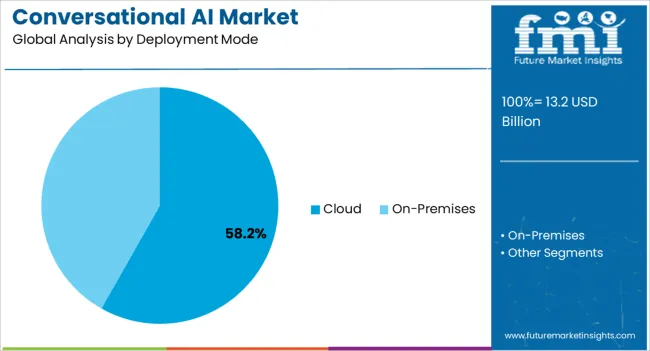
The cloud deployment mode is expected to hold 58.20% of total revenue by 2025, making it the leading segment within deployment models. This dominance is attributed to the scalability, flexibility, and cost advantages of cloud based systems.
Enterprises are increasingly opting for cloud deployment to support dynamic workloads, enable global accessibility, and integrate with existing IT infrastructure. The ability to deliver faster updates, ensure disaster recovery, and reduce upfront investment has reinforced the preference for cloud solutions.
With growing adoption of SaaS based platforms and demand for seamless integration across digital channels, the cloud deployment mode continues to lead adoption trends in conversational AI.
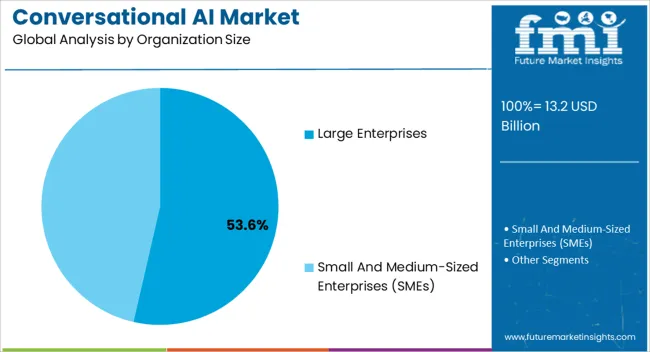
Large enterprises are anticipated to capture 53.60% of total market revenue by 2025 within the organization size category, maintaining their dominance in this segment. This is largely driven by their significant budgets, established digital transformation initiatives, and ability to scale AI integration across multiple functions and geographies.
Large organizations are leveraging conversational AI for customer support, sales, marketing, and internal workflows to enhance efficiency and brand engagement. Investments in AI innovation and partnerships with technology providers are further enabling advanced capabilities such as voice recognition, sentiment analysis, and predictive responses.
As a result, large enterprises continue to drive market leadership by setting benchmarks for adoption and operational effectiveness in conversational AI.
Increasing Customer Demand for Personalised Experiences
Businesses in a variety of industries are seeing the value of providing personalized and seamless consumer experiences. Conversational AI allows businesses to communicate with their customers in a more natural and personalized manner, resulting in greater adoption.
Natural Language Processing (NLP) and Machine Learning advancements
Breakthroughs in NLP algorithms and machine learning approaches have considerably increased conversational AI systems' ability. To interpret and respond to human language, boosting industry development.
Chatbots and Voice Assistants are Gaining Traction
Consumers are increasingly interested in voice assistants and chatbots. These conversational AI systems' simplicity and ease of use have accelerated their adoption in a variety of fields, including customer service, virtual assistants, and smart home devices.
Platforms for Messaging and Communication Expansion
Messaging apps and communication platforms like WhatsApp, Facebook Messenger, and Slack have become ingrained in people's daily lives. Integrating conversational AI capabilities into these platforms improves the user experience and offers up new avenues for businesses to communicate with customers.
Consumer Behaviour and Expectations are Changing
Customers are becoming more at ease interacting with AI-powered devices and have learned to demand personalized and efficient experiences. This shift in consumer behavior and expectations is leading businesses to employ conversational AI solutions to meet these demands.
Increasing Big Data and Cloud Computing Availability
Large amounts of data are now available, and advances in cloud computing infrastructure have laid a solid foundation for the development and deployment of conversational AI solutions. These technologies allow for the processing and analysis of massive amounts of data required for AI model training.
E-commerce Customization
By recognizing client preferences, offering product recommendations, and facilitating easy transactions, conversational AI allows personalized shopping experiences. There is a chance to develop AI-powered conversational interfaces that improve consumer engagement, conversion rates, and revenue growth.
Advisory Services in Finance
By providing personalized investment advice, budgeting assistance, and real-time financial information, conversational AI has the potential to disrupt the financial advisory profession. The market opportunity revolves around the development of AI-powered virtual advisors that cater to individual financial goals and deliver data-driven recommendations.
Assistance with Travel and Hospitality
Conversational AI has the potential to revolutionize the travel and hospitality industries by offering personalized suggestions, booking assistance, and real-time customer care. The market opportunity is to develop AI-powered travel concierges that improve client happiness, expedite bookings, and provide personalized travel experiences.
Virtual Assistants in Healthcare
Conversational AI can aid the healthcare business by adopting virtual assistants that can answer medical questions, book appointments, and provide basic healthcare counseling. The market opportunity is in creating HIPAA-compliant conversational AI technologies that improve patient care and streamline Administrative Processes.
Collaboration and Virtual meetings
With the advent of remote work comes an increased demand for AI-powered conversational interfaces that improve virtual meetings, simplify collaboration, and automate administrative tasks. The market opportunity entails developing intelligent virtual meeting assistants that help with communication, agenda management, and productivity.
Concerns about Data Privacy and Security
Conversational AI is based on collecting and analyzing massive volumes of user data, which creates privacy and security problems. Stricter rules and customer fear may impede the market growth.
Concerns about Ethics and Bias
Conversational AI systems may display biases or discriminatory behavior unwittingly, mirroring the biases contained in the training data. Addressing these ethical considerations and guaranteeing justice in AI systems represents a big industry challenge.
Adoption and Resistance by Users
Due to a lack of familiarity, fears about job displacement, or a preference for human connection, some consumers may be hesitant to adopt conversational AI. It can be difficult to persuade people of the benefits and utility of conversational AI.
Dependence on Internet Access
To work properly, many conversational AI applications require a stable internet connection. In some areas, limited or unreliable internet access can stymie user adoption and usage.
Natural Language Understanding (NLU) is lacking
Conversational AI systems are built to recognize and respond to human language. Accurate and contextually relevant responses, on the other hand, might be difficult to achieve, leading to user annoyance and discontent.
| Segment | Component |
|---|---|
| Segment Name | Solution |
| Segment Share | 59.3% |
| Segment | Type |
|---|---|
| Segment Name | Chatbots |
| Segment Share | 63.2% |
Services may account for a significant market share by component, with a CAGR of 16.6%. The functionality of conversational AI solutions depends heavily on the services sector. Solution and service providers handle these services, which is a necessary step in deploying technology solutions.
Due to the expanding demand for better customer service across key industries including BFSI, media and entertainment, and travel, conversational AI solutions are becoming more and more in demand internationally.
The chatbot sub-segment is anticipated to generate the most income by type over the projection period. The popularity of chatbots, which offer 24/7 customer support and enhance the customer experience, is a key factor in the sub-segment's quick growth.
Many industries, including finance, government, retail & eCommerce, travel & hospitality, and telecommunications, have shifted their focus to promptly responding to customer inquiries.
Large organizations and small and medium-sized enterprises (SMEs) are both in great demand in the conversational AI industry, albeit for different reasons. Large organizations, with their large resources and established customer bases, frequently seek advanced conversational AI solutions. To improve customer experience, automate operations, and boost operational efficiency. They have the resources to invest in strong and customized conversational AI systems.
SMEs are quickly recognizing the advantages of conversational AI in improving customer interactions, growing operations, and obtaining a competitive advantage. With more inexpensive and scalable solutions becoming available, SMEs are embracing Conversational AI to improve customer service, optimize sales processes, and expand their reach.
Overall, while large organizations may have a higher demand in terms of total numbers, SMEs are fast adopting conversational AI. Due to its potential to level the playing field and uncover new prospects for economic growth.
The deployment mode sector in the conversational AI market may be split into two groups: cloud and on-premises. The cloud deployment technique is currently in great demand and is flourishing on the market. Numerous benefits, including scalability, flexibility, ease of installation, and cost-effectiveness, are provided by cloud-based conversational AI solutions.
They do away with the requirement for complex infrastructure setup and upkeep, enabling organizations to benefit from conversational AI without making significant upfront investments. A simplified and interconnected ecosystem is made possible by cloud deployment's seamless connectivity with other cloud-based apps and services. The market for conversational AI is expanding as a result of the growing acceptance of the cloud deployment strategy.
The Banking, Finance Services, and Insurance (BFSI) industry has a strong demand for conversational AI solutions among the verticals mentioned in the Conversational AI market. This industry has a high demand for quick customer service, and personalized financial advice, and secures transactional processes.
Conversational AI technology allows virtual assistants and chatbots to address client inquiries, provide real-time financial analytics, help with account management, and provide personalized suggestions. With rising client expectations for seamless digital experiences and around-the-clock help, the BFSI sector recognizes the importance of conversational AI. In improving customer engagement, operational efficiency, and overall customer happiness.
| Countries | 2025 Value Share in Global Market |
|---|---|
| North America | 30.5% |
| Europe | 24.3% |
| Countries | 2025 Value Share in Global Market |
|---|---|
| United States | 21.1% |
| Germany | 10.4% |
| Japan | 7.5% |
| Australia | 2.6% |
| Countries | CAGR |
|---|---|
| China | 16.5% |
| India | 19.2% |
| United Kingdom | 18.2% |
When it comes to the adoption of conversational AI, North America is at the forefront. Key technology businesses, widespread internet use, and sophisticated infrastructure all support market expansion. In particular, conversational AI has been widely adopted across industries in the United States. The area is known for its dedication to innovation, with numerous businesses and academic institutions spearheading developments in conversational AI technology.
Another important region in the conversational AI business in Europe. Adoption is rising significantly in nations like the United Kingdom, Germany, France, and the Nordic nations. In the region, conversational AI is widely employed to improve customer experience and streamline operations in customer-centric industries including retail, banking, and telecoms. Governments in Europe have supported the advancement of AI technology, creating a favorable climate for the market for conversational AI to expand.
The conversational AI market is expanding quickly in the Asia Pacific area. Key contributors to this expansion include South Korea, China, Japan, India, and other nations. A big population, expanding smartphone penetration, and more digitalization across industries are factors promoting adoption. For instance, large IT companies in China are significantly investing in conversational AI, and the sector is seeing tremendous advancements in chatbots and voice assistants. Additionally, the region offers prospects for conversational AI applications in industries including banking, healthcare, and e-commerce.
With a sizable conversational AI market share, these firms are concentrating on growing their consumer base in new countries. These businesses are making use of strategic collaboration initiatives to grow their market share and profits.
Mid-size and smaller businesses, on the other hand, are expanding their market presence. By gaining new contracts and entering new markets, thanks to technical developments and product innovations.
Recent Advancements:
| Date | March 2024 |
|---|---|
| Company | Google Cloud |
| Details | Google Cloud announced the general availability of Vertex AI, a managed machine learning (ML) platform that allows companies to accelerate the deployment and maintenance of artificial intelligence (AI) models. |
| Date | April 2024 |
|---|---|
| Company | Microsoft |
| Details | Microsoft announced the acquisition of an AI-based technology company, Nuance Communications, for USD 19.7 billion in an all-cash transaction. The acquisition of Nuance expand Microsoft’s capabilities in voice recognition and transcription technology |
| Date | September 2025 |
|---|---|
| Company | Astro |
| Details | Astro is a new and different kind of robot, one that’s designed to help customers with a range of tasks such as home monitoring and keeping in touch with family. |
| Date | January 2024 |
|---|---|
| Company | AWS |
| Details | AWS made Amazon Lex chatbot integration available in Amazon Connect in the Asia Pacific (Sydney) AWS region. Amazon Lex chatbots can assist users in changing passwords, bringing up requested account balances, and scheduling an appointment by vocalizing a prompt. |
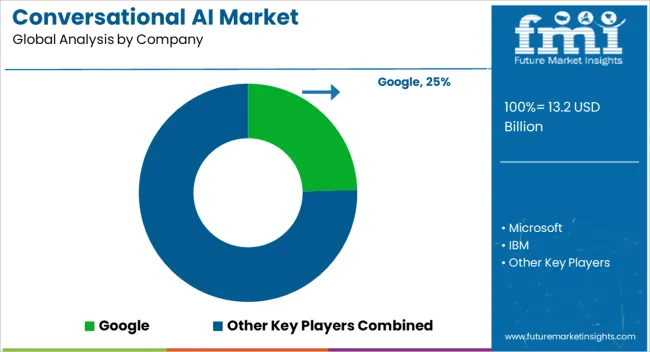
The global conversational AI market is estimated to be valued at USD 13.2 billion in 2025.
The market size for the conversational AI market is projected to reach USD 65.1 billion by 2035.
The conversational AI market is expected to grow at a 17.3% CAGR between 2025 and 2035.
The key product types in conversational AI market are chatbots and intelligent virtual assistants.
In terms of deployment mode, cloud segment to command 58.2% share in the conversational AI market in 2025.






Our Research Products

The "Full Research Suite" delivers actionable market intel, deep dives on markets or technologies, so clients act faster, cut risk, and unlock growth.

The Leaderboard benchmarks and ranks top vendors, classifying them as Established Leaders, Leading Challengers, or Disruptors & Challengers.

Locates where complements amplify value and substitutes erode it, forecasting net impact by horizon

We deliver granular, decision-grade intel: market sizing, 5-year forecasts, pricing, adoption, usage, revenue, and operational KPIs—plus competitor tracking, regulation, and value chains—across 60 countries broadly.

Spot the shifts before they hit your P&L. We track inflection points, adoption curves, pricing moves, and ecosystem plays to show where demand is heading, why it is changing, and what to do next across high-growth markets and disruptive tech

Real-time reads of user behavior. We track shifting priorities, perceptions of today’s and next-gen services, and provider experience, then pace how fast tech moves from trial to adoption, blending buyer, consumer, and channel inputs with social signals (#WhySwitch, #UX).

Partner with our analyst team to build a custom report designed around your business priorities. From analysing market trends to assessing competitors or crafting bespoke datasets, we tailor insights to your needs.
Supplier Intelligence
Discovery & Profiling
Capacity & Footprint
Performance & Risk
Compliance & Governance
Commercial Readiness
Who Supplies Whom
Scorecards & Shortlists
Playbooks & Docs
Category Intelligence
Definition & Scope
Demand & Use Cases
Cost Drivers
Market Structure
Supply Chain Map
Trade & Policy
Operating Norms
Deliverables
Buyer Intelligence
Account Basics
Spend & Scope
Procurement Model
Vendor Requirements
Terms & Policies
Entry Strategy
Pain Points & Triggers
Outputs
Pricing Analysis
Benchmarks
Trends
Should-Cost
Indexation
Landed Cost
Commercial Terms
Deliverables
Brand Analysis
Positioning & Value Prop
Share & Presence
Customer Evidence
Go-to-Market
Digital & Reputation
Compliance & Trust
KPIs & Gaps
Outputs
Full Research Suite comprises of:
Market outlook & trends analysis
Interviews & case studies
Strategic recommendations
Vendor profiles & capabilities analysis
5-year forecasts
8 regions and 60+ country-level data splits
Market segment data splits
12 months of continuous data updates
DELIVERED AS:
PDF EXCEL ONLINE
Conversational AI in Healthcare Market Size and Share Forecast Outlook 2025 to 2035
AI Code Assistant Market Size and Share Forecast Outlook 2025 to 2035
AI-Based Data Observability Software Market Size and Share Forecast Outlook 2025 to 2035
Air Fryer Paper Liners Market Size and Share Forecast Outlook 2025 to 2035
Air Struts Market Size and Share Forecast Outlook 2025 to 2035
AI-powered Wealth Management Solution Market Size and Share Forecast Outlook 2025 to 2035
Airless Paint Spray System Market Size and Share Forecast Outlook 2025 to 2035
AI Powered Software Testing Tool Market Size and Share Forecast Outlook 2025 to 2035
AI Document Generator Market Size and Share Forecast Outlook 2025 to 2035
AI in Fintech Market Size and Share Forecast Outlook 2025 to 2035
Air Caster Skids System Market Size and Share Forecast Outlook 2025 to 2035
AI-Driven HD Mapping Market Size and Share Forecast Outlook 2025 to 2035
AI Platform Market Size and Share Forecast Outlook 2025 to 2035
AI-powered Spinal Surgery Market Size and Share Forecast Outlook 2025 to 2035
AI-Powered Sleep Technologies Market Size and Share Forecast Outlook 2025 to 2035
AI-Powered Gait & Mobility Analytics Market Size and Share Forecast Outlook 2025 to 2035
AI-Powered Behavioral Therapy Market Size and Share Forecast Outlook 2025 to 2035
AI-Enabled Behavioral Therapy Market Size and Share Forecast Outlook 2025 to 2035
AI-powered In-car Assistant Market Forecast and Outlook 2025 to 2035
Airborne Molecular Contamination Control Services Market Forecast and Outlook 2025 to 2035

Thank you!
You will receive an email from our Business Development Manager. Please be sure to check your SPAM/JUNK folder too.
Chat With
MaRIA